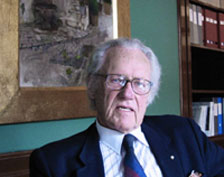Lars Werkö
Year: September 5th, 2005
Location: Stockholm, Sweden
Interviewed by: Pyörälä, Kalevi
Abstract
Lars Werko is a leading cardiologist in Sweden who introduced cardiac catheterization there and started the first CVD epidemiology unit in Sweden at Goteborg with pupil Gosta Tibblin. This interview contains material on the development of cohort studies among men born in 1913 with the object to remove age variation in predictions from risk factors and on the development of primary and secondary multifactor prevention trials.
Werko eventually became highly critical of diet-heart theory (mainly based on the weak measurements of diet, the too facile early focus on diet fats, plus his own leaning toward the import of tobacco effects). There is discussion of the small intervention effects of the Goteborg and the U.S. multiple risk factor trials, the unexplained decline in population levels of blood pressure and cholesterol, the disappearance of malignant hypertension, the rise of the “metabolic syndrome,” and the unexplained effect on risk of social class. (HB)
Quotes
And I think this is something that the school of medicine doesn’t really understand and doesn’t really take into account, that the disease panorama is changing. High blood pressure is changing, blood lipids are changing, and we don’t know why.
I think one of the drawbacks of the whole history of epidemiology has been that you have focused too much on nutrition and too little on the biological factors, because there is no question that cholesterol plays some role. But it is very difficult to know what you eat and how you eat and how much that really plays a role.
“Other Risk Factors”
And the question is not at all impossible that there may be some link between these and the central nervous system, because there is one issue, which is quite obvious but hasn’t been used enough, and that is the relation between social class and the stresses in society and coronary heart disease.
Men of 1913
. . the Director General of the National Health Board of Health Services, Artur Engel, asked me to be their consultant on the use of fat in nutrition, because they had a department within this organization that [had] the responsibility to supervise the modern food industry and they wanted to have a medical man to consult them and they asked me to do this because I was a young, newly appointed professor. And I accepted and that is why I got interested in nutrition. Then one of my disciples came to me and said, “This study that has been done on the Seven Countries is interesting and they have shown several things, but I think that one of the drawbacks of this is that they don’t take enough care of the ages of the persons, because they are using a mathematical formula to compensate for different age groups. But you can’t really do that. So I had the idea that you should investigate one age group only and look at that.”
And that was Gösta Tibblin who told me that and asked “What do you think about that? Do you think we could do that?” And I immediately agreed with him. Of course, I thought that was really a very good observation because I had also questioned this use of mathematical formulas for compensating for ages. I agreed that it was a good idea and supported him and we were the only ones in the whole medical department in Göteborg who thought so, because other people said that it is absolutely crazy and that you can’t get enough people, you can’t follow them up for a time long enough, and you won’t get results until after 5 or 10 years and so on. So there was quite a lot of resistance to this idea, but I was the chief and I could get some money from different foundations and Gösta was young and willing to work. So he did the whole study himself under my supervision. (3)
Diet-Heart Origins
Asked about Haqvin Malmros 1950 paper in Acta Medica Scandinavica showing that mortality went down during the war years:
Yes, but that paper is really not very good. It’s nearly bad because he was using United States and Norway and Sweden and he showed that there was a decrease in deaths due to diagnosis that was called cardiosclerosis and he connected that with the amount of eggs that were eaten and he had very bad material really. But the idea was the same as Keys had and so it was supported. At that time Malmros was not yet in Lund. He was then Chief Physician in Örebro and became later Professor of Medicine at the University of Lund. But he was absolutely sold on the danger of egg yolks.(5)
I think this is something that the school of medicine doesn’t really understand and doesn’t really take into account that the disease panorama is changing. High blood pressure is changing, blood lipids are changing, and we don’t know why. (10)
Full Transcript Access
Full transcripts of interviews may be made available to those engaged with original materials for scholarly studies by contacting us.
